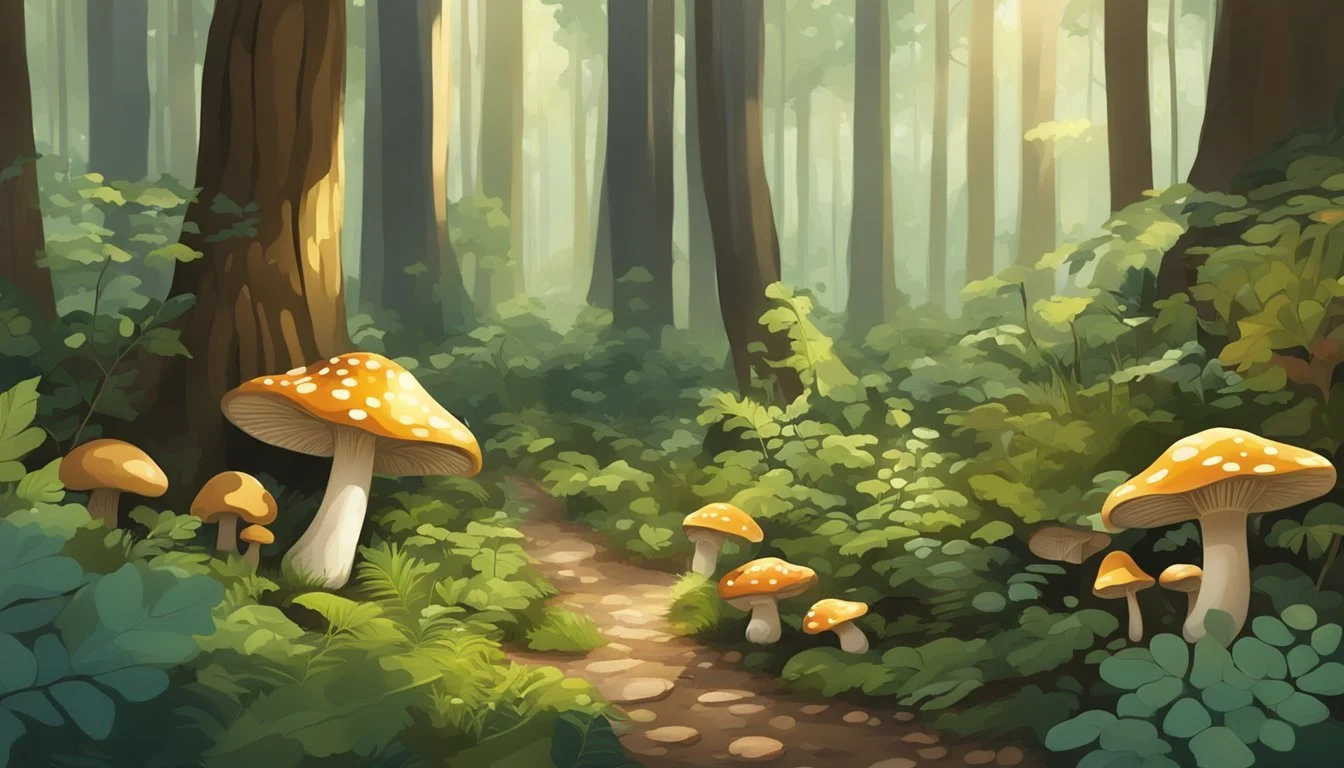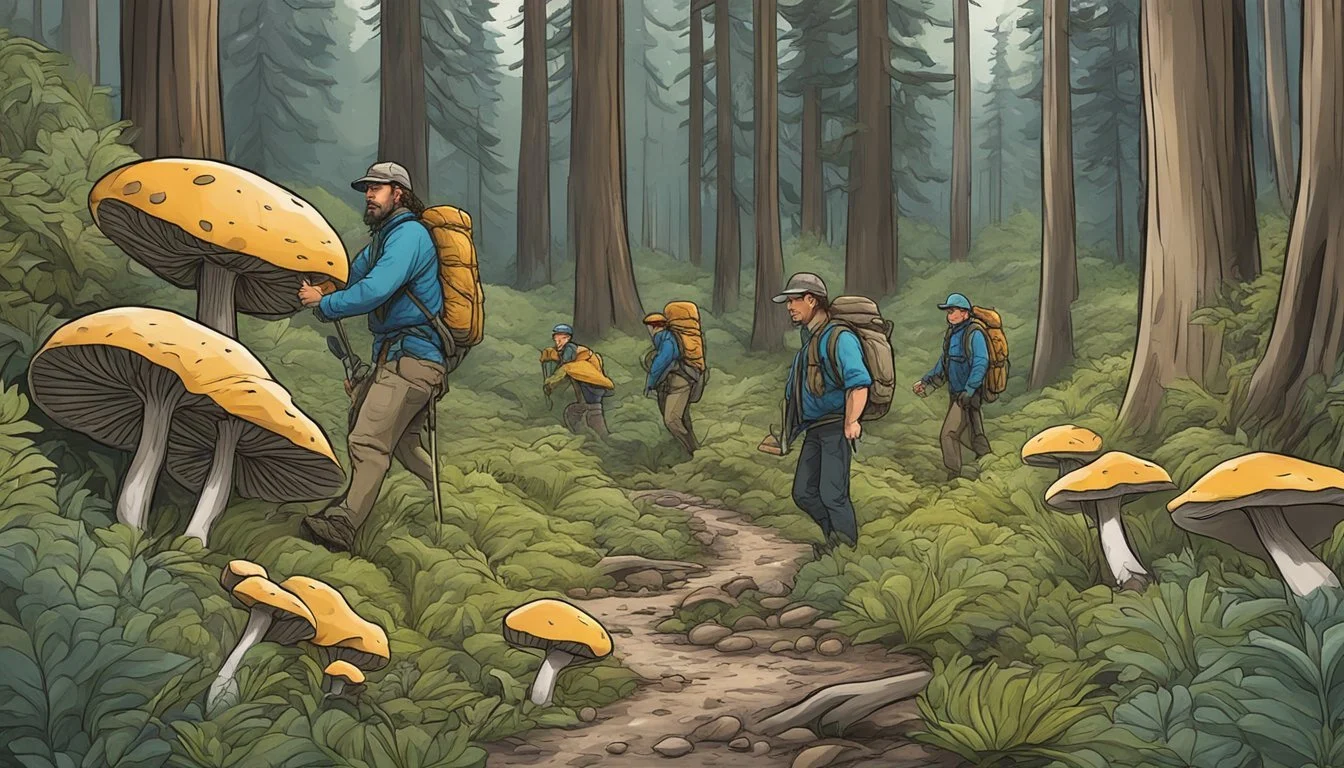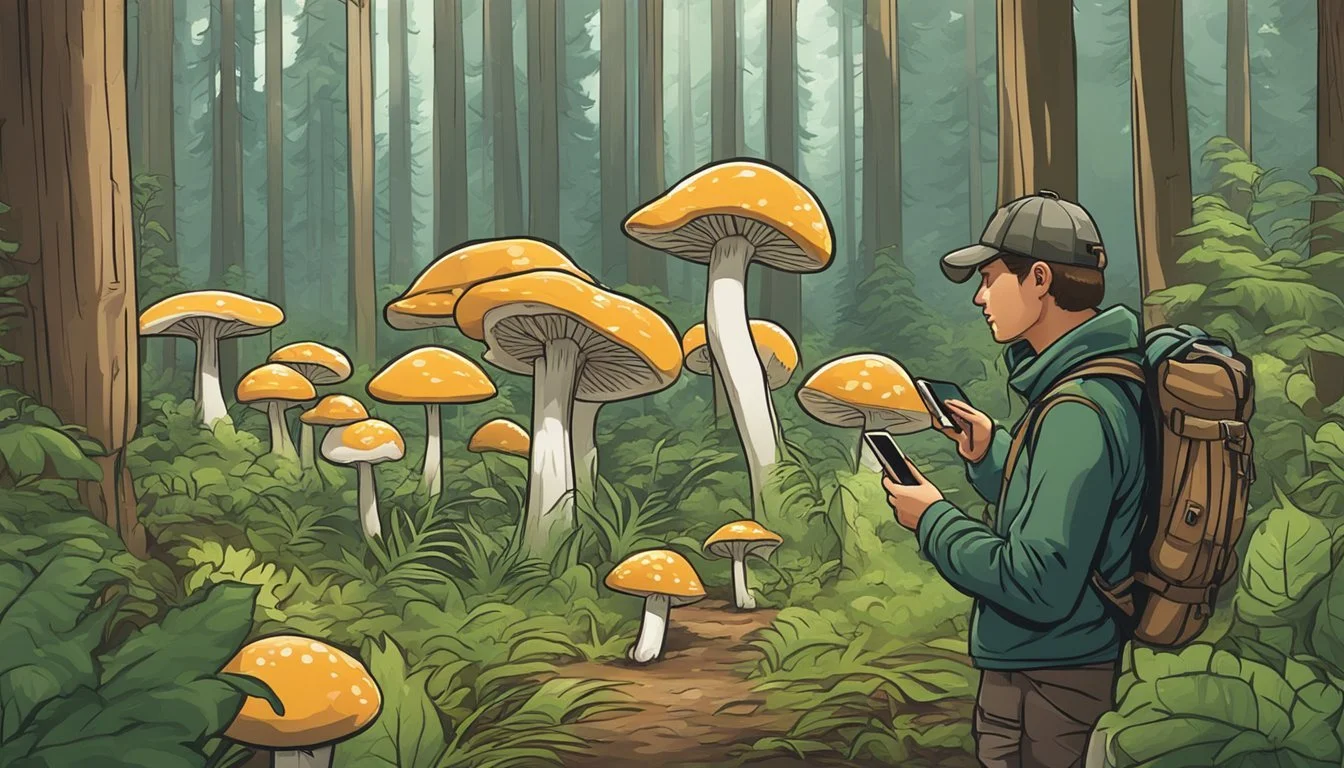Mushroom Hunting Montana
A Guide to Safe Foraging Practices
This Article is Part of Our Guide on Mushroom Hunting for All 50 States
Montana's varied landscapes offer a rich habitat for a diversity of mushrooms, making it a popular destination for enthusiasts of mushroom hunting. The state's forests and mountainous regions create an environment well-suited for fungal growth, especially after seasonal rains. Mushroom hunters are drawn to the area with the hopes of finding species such as the sought-after morels in spring or the hearty Boletes in fall.
Mushroom foraging in Montana requires a good understanding of the local species and their habitats. Species like the Apricot Jelly, Bear's Head, and Chicken of the Woods are commonly sought in the state's woods from spring through fall. Golden Chanterelles are known to pop up in early autumn, while the renowned morels make their appearance in late spring, growing in symbiotic relationships with certain trees and thriving in areas disturbed by fires from previous years.
Safety is paramount when hunting for mushrooms, and foragers should be equipped with the right tools, such as a mesh bag or basket, a sharp knife, and reliable identification guides. The changing seasons offer an ever-shifting palette of fungi to discover, and the thrill of the hunt keeps foragers returning to Montana's forests with each passing year. Whether experienced or new to the hobby, mushroom hunters must always verify their finds with care to avoid mistaking edible varieties for potentially toxic look-alikes.
Foraging for More Than Just Mushrooms in Montana
Montana's rugged wilderness, from the Rocky Mountains to the Great Plains, offers a diverse array of wild edibles for the adventurous forager. While mushrooms are a prized find, the Treasure State's rich ecosystems provide a bounty of berries, nuts, greens, and roots. Discover the joys of foraging and connect with nature's abundance in Montana's breathtaking landscapes.
👉 Foraging for Wild Edibles in Montana
Commonly Found Edible Mushrooms in Montana
Montana is home to several edible mushroom species. Some of the most commonly found edible mushrooms in the state include:
Morel (Morchella spp): Commonly found in Montana, morel mushrooms have a distinctive honeycomb appearance and are prized for their rich, earthy flavor, making them a sought-after culinary delicacy.
Porcini (Boletus edulis): Often found in Montana, porcini mushrooms have a nutty flavor and are sought after for their meaty texture, making them a popular choice for cooking and foraging.
Chanterelle (Cantharellus spp): These golden to yellowish-orange mushrooms are often found in wooded areas in Montana and have a delicate, fruity aroma and a mild, peppery taste, making them a popular choice for cooking and foraging.
Lobster Mushroom (Hypomyces lactifluorum): Frequently found in Montana, lobster mushrooms are a parasitic fungus that grow on certain species of mushrooms, giving them a seafood-like flavor and a vibrant red color, making them a unique culinary find.
Meadow Mushroom (Agaricus campestris): Commonly found in Montana, meadow mushrooms have a mild flavor and are often found in grassy areas, making them a popular choice for mushroom foragers.
It is essential to properly identify any mushroom before consuming it, as some species can be poisonous. Beginners should go mushroom hunting with an experienced guide or join a local mycological society to learn how to identify edible mushrooms safely.
Essential Tips for Mushroom Hunters
Whether novices or experienced foragers, mushroom hunters in Montana must equip themselves with specific knowledge and tools for a successful and ethical harvest. This includes understanding mushroom habitats, identifying edible species accurately, adhering to safety and foraging ethics, and utilizing the right equipment.
Understanding Mushroom Habitats
Mushroom hunters should familiarize themselves with the environments that different mushrooms favor. Morels, for instance, thrive in the spring in areas that have experienced burns, whereas the king bolete and chanterelles are typically found in deciduous or coniferous forests during the fall. Recognizing these habitats can significantly increase the chances of a fruitful hunt.
Burned Areas: Late spring following a burn for morels.
Coniferous Forests: Favorable for boletus species like king boletes in the fall.
Deciduous Forests: Golden chanterelles emerge in early autumn.
Identifying Edible Species
Accurate identification is crucial to avoid consuming toxic mushrooms. Equip oneself with a reliable field guide or consider an app designed for mushroom species identification. Specific characteristics, such as cap shape, color, and gill structure, are key distinguishing features to help differentiate edible species from their toxic lookalikes.
Shape: Compare cap and stem shapes with illustrations or photos.
Color: Note the exact shade of the cap, stem, and gills.
Gills: Observe their attachment to the stem and spacing.
Safety and Foraging Ethics
Safety is paramount when foraging for mushrooms. Always carry a first aid kit and ensure that cell phones are charged for emergencies. Respect private property and public land regulations, and practice sustainable foraging by taking only what is needed and leaving the ecosystem undisturbed for future growth.
First Aid Kit: Always include in foraging gear.
Cell Phone: Fully charged for emergency communication.
Sustainable Harvest: Take only a portion of the mushrooms found.
Equipment and Tools
Proper tools can make the difference in foraging. A basket or mesh bag allows for spore dispersal, helping to promote future mushroom growth. Bring a small knife for clean cuts and gloves for protection. A compass or GPS device is also helpful to navigate the often dense Montana woodlands.
Basket / Mesh Bag: For carrying mushrooms and spore dispersal.
Knife: Essential for harvesting mushrooms with minimum damage to mycelium.
Compass/GPS: To navigate and mark productive spots without getting lost.
Morel Mushrooms in Montana
Montana offers an excellent backdrop for morel mushroom enthusiasts, with its diverse habitats and distinct seasons.
Habitat and Locations
Morel mushrooms favor the temperate regions of Montana, particularly thriving in areas disturbed by natural occurrences such as wildfires. They are often found at lower elevations in the spring, as these regions warm up sooner. Forested areas with a mix of tree species, including aspen and elm, tend to be promising spots. Hunters should focus on moist, well-drained soils near riverbanks or in forested areas with ample organic matter.
Timing and Seasonality
The prime time for morel hunting in Montana begins in mid-April and extends to early June, with peak fruiting typically occurring in mid-May. These mushrooms emerge when the ground temperature approaches 50 degrees Fahrenheit. Their growth cycle corresponds closely with the spring season, as morels make the most of the moist soil conditions before the onset of the hot, dry summer.
Morel Mushroom Identification
Identifying morel mushrooms involves looking for their distinctive honeycomb-like caps. They are generally classified into two types: yellow and black morels. When distinguishing these mushrooms, one must consider features such as:
Cap shape: Conical with pits and ridges
Cap color: Ranging from tan to dark brown
Stem: White to pale, and thicker compared to the cap
As with any foraging activity, it's crucial to use a reliable guidebook or consult an expert to avoid mistaking morels for toxic look-alikes. Hunters should equip themselves with a mesh bag or basket to allow spore dispersal, ensuring the continuation of morel populations for future seasons.
Other Popular Mushrooms in Montana
Montana's diverse ecosystems support a variety of sought-after mushrooms. From the flavorful chanterelles to the prized pine mushrooms, each species thrives in specific habitats providing unique foraging experiences.
Chanterelles and Their Ecosystem
Chanterelle Mushrooms (Cantharellus cibarius) are renowned for their golden hue and fruity aroma. These mushrooms typically emerge in the early autumn period within:
Moist, well-drained areas
Mixed hardwood forests, often alongside oaks and beeches
Symbiotic relationship with living trees, benefiting from coniferous and deciduous settings
Pine Mushrooms and Preferred Forests
Pine Mushrooms, also known as Matsutake (Tricholoma magnivelare), favor different terrains. They are found in regions with:
Mature coniferous forests, especially those populated with pines
A symbiotic association with spruce trees which plays a crucial role in their life cycle
They begin to appear in late summer and reach into the fall.
Unique Varieties: Shaggy Manes and Matsutake
Shaggy Mane Mushrooms (Coprinus comatus) are notable for their distinct appearance and rapid decomposition once picked. They grow in:
Grasslands, gardens, and disturbed grounds after rains in the fall season
Contrastingly, the White Matsutake (Tricholoma magnivelare) is highly revered, often found in:
Similar environments as Pine Mushrooms, predominantly under coniferous trees like pines and spruces
Areas with well-drained soil and a healthy litter layer which promote their growth
Poisonous Mushrooms and False Morels
When mushroom hunting in Montana, it is crucial to distinguish between edible species like true morels and their toxic counterparts, notably the false morels. False morels carry substantial risks, as they contain hydrazine toxins that are not always eliminated by cooking. Consumption can lead to severe illness or even fatality.
Identifying false morels can be challenging. They often mimic the appearance of true morels, but tell-tale differences exist:
Cap Shape: True morels have a honeycomb-like cap with deep pits. False morels are often irregular or lobed.
Cap Attachment: On true morels, the cap attaches directly to the stem with no space. False morels typically have a cap that hangs freely from the top of the stem.
Stem: True morels have a hollow stem, while false morels have a stem that can be stuffed with cottony or fibrous material.
Precautions should be taken when foraging:
Never consume mushrooms unless positively identified as safe by an expert.
Use resources such as identification guides or apps, but treat them as supplementary to expert advice.
Carry your finds in a mesh bag to avoid spore spread, promoting ecosystem health.
The distinctions are subtle but crucial for safe morel mushroom hunting. The health implications underscore the need for careful identification and handling of wild mushrooms.
Foraging on Public Lands and Legal Considerations
In Montana, foragers must navigate a set of regulations when harvesting mushrooms on public lands. They should be aware that personal use permits are typically required for individuals aged 12 or older wishing to collect mushrooms. It's crucial to distinguish between personal use and commercial harvesting, as the permits and regulations differ.
Permits and Regulations:
Personal Use Permits: Generally free, allowing for non-commercial foraging.
Commercial Use Permits: Necessary for those intending to sell mushrooms, subject to fees.
Foragers should obtain permits from the U.S. Forest Service or relevant local agencies before commencing their mushroom collection. The laws are in place to protect both the natural resources and the safety of individuals foraging.
Key Points for Foragers:
Check specific areas on public lands for any unique restrictions.
Stay informed about seasonal guidelines; certain times of the year may have more stringent rules to prevent over-harvesting.
Ensure identification of mushrooms is accurate to avoid collecting protected or poisonous species.
Abiding by these regulations helps maintain the ecological balance of Montana's forests and ensures the continuation of mushroom harvesting for future generations. It's the forager's responsibility to stay educated and respect the guidelines set forth by public land management entities.
Mushroom Preparation and Culinary Uses
When one has successfully hunted mushrooms in Montana, the next crucial steps are their proper preparation and exploration of their culinary potential. Mushrooms must be handled with care to maintain quality and safety.
Cleaning and Storage
Mushrooms should be cleaned gently with a soft brush to remove dirt and forest debris. If necessary, a quick rinse can help, but they should not be soaked as they absorb water. Care with cleaning preserves their texture and taste. For storage, mushrooms are best kept in the refrigerator in a paper bag which allows them to breathe and remain fresh for a few days. Freezing is also an option for long-term storage, particularly after sautéing or blanching, which locks in flavor and texture.
Cooking Techniques
Chefs often employ a variety of techniques to bring out the best in mushrooms. Sautéing in butter or oil on high heat until golden brown enhances their natural umami flavor. They can also be grilled, roasted, or steamed. Essential to note is not to crowd the pan, as mushrooms release water while cooking, which can lead to steaming rather than browning if they are too close together.
Mushroom-Based Dishes in Restaurants
Restaurants specializing in local cuisine may offer impressive mushroom-based dishes that showcase the flavors of Montana's wild fungi. Options might include risottos, pasta (how long does pasta last?) dishes, or hearty stews, all incorporating mushrooms for depth of flavor. Popular edible mushrooms, like morels or chanterelles, are often featured, revealing their distinctive tastes and textures in expertly crafted dishes.
The culinary potential for wild mushrooms is extensive, with each species offering unique opportunities for flavor and creativity in the kitchen.
Conservation and Sustainability Practices
When engaging in mushroom hunting in Montana, enthusiasts must adhere to conservation and sustainability practices to ensure the viability of wild mushroom populations and the health of the forest ecosystem. It is important to respect soil integrity and maintain the nutrient balance essential for sustainability.
Soil Type: The health of the forest floor is crucial, as certain fungi promote seedling growth and soil carbon retention. After forest fires, nearly 80% of the biomass remains and contributes to regrowth; indiscriminate mushroom harvesting can disrupt this natural cycle.
Sustainability: Only collect quantities of mushrooms that are needed for personal use, and avoid over-harvesting to allow populations to regenerate. It's necessary to be mindful of the life cycle of mushrooms to avoid interrupting their spore dispersal.
Foraging Restrictions:
Always check with local authorities or park officials for any current restrictions on mushroom foraging, specifically in protected areas like Glacier National Park.
Follow legal guidelines and practice ethical foraging by not disturbing the surrounding flora or fauna.
Environmental Impact: Remember that mushrooms serve as bioindicators of the forest’s health. Their presence often indicates a well-balanced ecosystem, and their absence may signal ecological distress.
In summary, mushroom hunters should harvest responsibly, considering the delicate balance of the ecosystem. By following these practices, they ensure the conservation of Montana's diverse mycological species for future generations.
Mushrooming Culture in the Pacific Northwest
The Pacific Northwest (PNW), characterized by its lush forests and cool, moist climate, is a haven for mushroom enthusiasts. In states such as Oregon, Washington, and even into western Montana, foraging for mushrooms has become a popular activity among locals and visitors alike.
The region's diverse ecosystems support a wide variety of edible mushrooms, notably the prized Chanterelle, Morel, and King Bolete. The culture of mushroom hunting in the PNW is one of both tradition and science, with foragers following the rhythms of the seasons and the guidance of local mycological societies.
In Oregon, mushroom foragers find a rich landscape teeming with fungous flora. The state's counties offer bountiful harvests, which do not typically include psychedelics but are focused on culinary varieties. Foragers in the PNW often share an ethos of sustainability and conservation, taking care to harvest responsibly.
Educational resources play a significant role in mushrooming culture. Field guides and local associations provide invaluable information on species identification and foraging etiquette. Beginners are encouraged to learn from experienced foragers and to always confirm a mushroom's edibility before consumption.
Notable Mushrooms in the PNW Chanterelle (Cantharellus spp.) Morel (Morchella spp.) King Bolete (Boletus edulis)
As interest in foraging grows, so does the mushrooming culture in the PNW, continuing to thrive on a blend of community knowledge, natural abundance, and respect for the forest's fungal inhabitants.
Enhancing Mushroom Hunting with Technology
Advancements in technology have provided mushroom hunters with innovative tools to enrich their foraging experience. These technologies assist in identifying mushrooms, mapping locations, and connecting with expert knowledge.
Mushroom Foraging Apps and Maps
For the modern mushroom hunter, several apps have become invaluable for navigating the forests of Montana. These applications offer real-time GPS mapping features that track and mark spots where mushrooms are found. Using an app, a forager might access a vast database of mushroom maps, which are often populated with contributions from users who mark sightings of morel mushrooms and other species.
Additionally, these apps contain extensive libraries of mushroom identification features, helping enthusiasts to distinguish between edible and toxic varieties. Some are equipped with image recognition software, enabling users to take a photo of a mushroom and receive immediate species information. Here is an example of what users might find within such an app:
Mushroom Identification: Photos, descriptions, habitat information.
Location Services: Real-time GPS tracking and marking of forage sites.
Online Communities and Forums
Online communities and forums have emerged as hubs where mushroom hunters can share experiences, tips, and identify finds. Experienced foragers and professional mycologists frequent these platforms, offering advice and insights. Users can upload photos of their discoveries and get input on the species and edibility of the mushrooms they encounter.
These internet-based platforms also provide a space where users can discuss optimal hunting times and locations, as informed by the contributing community’s observations and experiences. For example, insights such as the ideal time to forage post-rainfall or during certain months are regularly exchanged within these communities, along with the following:
Species Information: Edibility, habitat, and growth patterns.
Community Knowledge: Shared by both amateurs and mycologists.
Technology, through the use of mushroom hunting apps and vibrant online forums, has indeed revolutionized the way we approach mushroom foraging in Montana.







